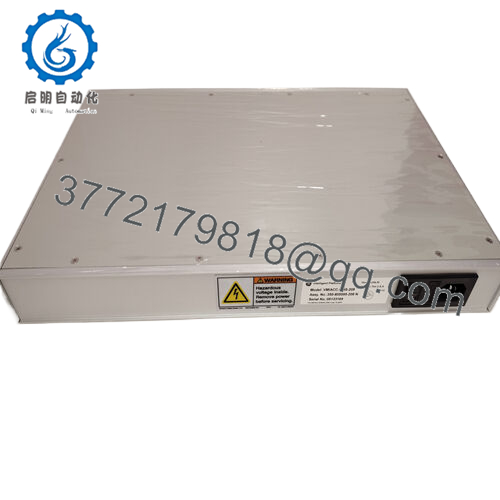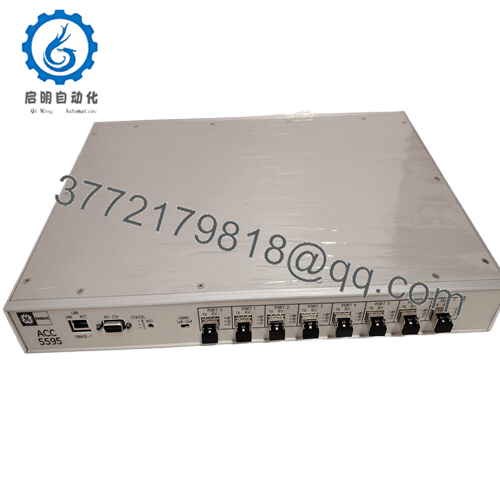Description
The GE VMIACC-5595-208 (also referenced as 350-805595-208N) is a high-performance Reflective Memory Hub Assembly designed for industrial control systems, particularly within GE’s Speedtronic Mark V and Mark VIe distributed control environments. This hub is critical in achieving ultra-fast and reliable data sharing across multiple nodes in real-time applications where system synchronization, fault tolerance, and redundancy are vital. It finds use in power generation plants, petroleum refining, chemical processing, and other heavy industries requiring continuous, deterministic data replication and low-latency control communication over fiber optic networks. The GE VMIACC-5595-208 supports industrial automation and control architectures by linking reflective memory devices, ensuring coherent and synchronized data updates for high-availability control solutions.
The GE VMIACC-5595-208 is a managed reflective memory hub module that supports up to eight ports using industry-standard Small Form Factor Pluggable (SFP) transceivers. Its architecture allows cascading of multiple hubs up to a 256-node network, offering high scalability without degradation in data transmission performance. The device automatically bypasses defective or disconnected nodes in the fiber optic loop, improving network resilience and minimizing downtime. Configurable options include port bypass modes based on signal loss or synchronization absence, manually controlled port activation, and remote monitoring capabilities through an integrated 10BaseT Ethernet interface and RS232 serial connection. The module is available in either desktop or 1U rack-mount enclosures, providing flexible installation options. This hub is essential for facilitating reflective memory data exchange at 2 Gb/s rates, making it an asset for GE embedded systems requiring fast and reliable data interchange.
Technically, the GE VMIACC-5595-208 supports multimode optical ports with wavelengths ranging from 830 to 860 nm and cable lengths up to 300 meters, alongside single-mode options supporting longer distances of 10 km to 80 km at wavelengths up to 1570 nm. The unit’s intelligent design regenerates optical signals to mitigate insertion loss and jitter, maintaining signal integrity over extensive fiber optic connections. Its Ethernet controller complies with TCP/IP standards, providing a unique MAC address and support for local and wide area network communication. Built with a robust universal power supply accepting 90 to 264 VAC at frequencies from 47 to 440 Hz and consuming about 25W, it is engineered for global industrial applications. The VMIACC-5595-208 operates reliably within 0 to +65°C ambient temperature and offers extensive regulatory and safety certifications such as UL, C-UL, TUV, and CE.
- VMIACC-5595-208 350-805595-2008N
| Parameter | Value |
|---|---|
| Model | VMIACC-5595-208 (350-805595-208N) |
| Brand | General Electric (GE) |
| Product Type | Reflective Memory Hub Assembly |
| Data Transfer Rate | 2 Gb/s |
| Number of Ports | 8 SFP transceiver ports |
| Optical Wavelength | Multimode: 830–860 nm; Single-mode: 1300–1570 nm |
| Maximum Cable Length | Multimode: 300 m; Single-mode: up to 80 km |
| Communication Interfaces | 10BaseT Ethernet, RS232 |
| Power Supply | 90–264 VAC, 47–440 Hz, 25 W |
| Operating Temperature | 0°C to +65°C |
| Dimensions | Desktop: 16.73″ × 10.0″ × 1.72″ (1U height) |
| Mounting Options | Desktop or 1U 19-inch rack |
| Certifications | UL, C-UL, TUV, CE (EN55022, EN61000, FCC) |
Relevant compatible or related GE modules:
VMIACC-5595-204 – Similar reflective memory hub with configuration differences.
VMIVME-7750 – VME-based processor module for embedded control systems integration.
VMIVME-7614 – Additional VME I/O module complementing reflective memory networks.
IC698RMX016-ED – Redundant memory expansion module improving system fault tolerance.
VMIVME-5530S – Analog input/output modules supporting VME-based automation equipment.
Before installation, ensure the control cabinet provides suitable 19-inch rack space or desktop placement with sufficient ventilation. Confirm proper grounding and stable AC power supply matching 90–264 VAC requirements. Use recommended fiber optic cables (duplex LC or simplex LC) as specified to ensure optimal signal integrity and cascading efficiency. Maintenance involves monitoring LED indicators for port status and synchronization, firmware upgrades via Ethernet interface for improved features, and periodic cleaning of SFP connectors to prevent signal degradation.



 WhatsApp: +86 16626708626
WhatsApp: +86 16626708626 Email:
Email:  Phone: +86 16626708626
Phone: +86 16626708626


